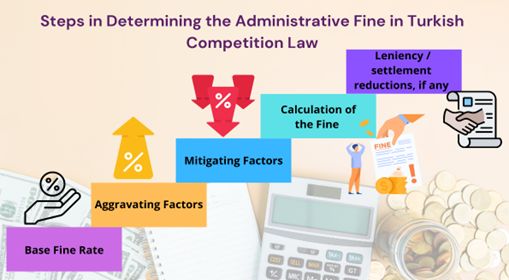- within Antitrust/Competition Law topic(s)
- within Energy and Natural Resources, Tax and International Law topic(s)
- with readers working within the Media & Information industries
The Guidelines on Fines to Apply in Cases of Agreements, Concerted Practices and Decisions Limiting Competition, and Abuse of Dominant Position ("Guidelines") have recently been published by the Turkish Competition Authority ("TCA") on February 19, 20251, following the entry into force of the new Regulation on Fines to Apply in Cases of Agreements, Concerted Practices and Decisions Limiting Competition, and Abuse of Dominant Position ("Regulation") on December 27, 2024 (which was previously analyzed in our team's article titled "Turning The Page: The New Framework To Competition Law Fines"). The Guidelines outline the principles for determining the administrative fines to be imposed in cases of competition infringement, the criteria to be taken into account for determining the base fine rate, the evaluation of violation period, the issues to be considered in discretionary aggravating and mitigating factors, the final fine rate and example scenarios for the calculation of the fines.
The Guidelines explain the need for change in enforcement policy due to the evolving nature of markets where competition law is applied. As these markets increasingly diverge from traditional ones, shifts in business models and consumer preferences have also altered both the types of violations encountered and the characteristics of entities subject to competition law. It is stated that the rise in market power due to the cross-border activities of large technology companies controlling critical assets such as user data, the spread of competition violations across a broad economic spectrum, and the negative effects of algorithmic and data-driven monopolistic practices on digital markets and consumer welfare have underscored the need for the Competition Board ("Board") to revisit its enforcement policy. The Regulation is said to be adopted to increase the effectiveness of the penalty policy, strengthen the purpose of establishing deterrence, and ensure predictability and legal certainty.
This article examines the key aspects of the Guidelines, highlighting significant principles governing administrative fines to be applied for violations of competition rules.
Principles on Determination of Administrative Fine
The Regulation abandons the previous approach of determining base penalty rates solely based on classifying violations as "cartels" or "other infringements". Instead, a new method is adopted that considers the nature of the violation and its negative impact on competition. Accordingly, the lower and upper limits tied to this classification have been removed. Thus, the goal is to consider the nature of the violation and its actual or potential negative impact on competition when determining the base fine rate.
The Board will assess whether the actions of the undertakings
lead to one or more violations, applying separate penalties for
each individual violation. In this context, whether an
undertaking's actions constitute a single violation will be
determined on a case-by-case basis, considering several factors
outlined in the Guidelines. The administrative fine imposed cannot
exceed 10% of the undertaking's annual revenue for each
violation;
therefore, any fines above this threshold will be reduced to 10% of
the annual revenue. Furthermore, any reductions under the Active
Cooperation and Settlement Regulations will be calculated based on
the final penalty amount.
Steps in Determining the Administrative Fine

1. Determining the Base Fine Rate: The Guidelines emphasize that factors depending on the nature of the violation, the damage it has caused or may cause, and its duration will be taken into account when determining the base fine rate. Conditions specific to the undertaking will be considered in determining the final fine rate as aggravating and mitigating factors.
- Initial Fine Rate: When determining the initial fine rate, the Board will consider the severity of the actual or potential harm caused by the violation and whether the nature of the violation is naked or hardcore. In this regard, harm as a factor will be assessed not only based on competition in the relevant market, but also by considering other interests protected by competition, as well as the actual or potential negative effects. For instance, anti-competitive behaviours that could impede national economic development, complicate macroeconomic policy implementation, or make it difficult to address force majeure situations (such as earthquakes, fires, or pandemics) may be considered when determining the initial fine rate. Moreover, the severity of the existing or potential harm may vary depending on factors such as the degree and intensity of the violation, the position of the parties in the relevant market, the products affected, and the geographic scope of the violation. The Guidelines provide certain comparisons of various violations to clarify the cases where the gravity of the damage will be greater.
- Nature of the Violation: Under the Regulation, the nature of violation refers to whether it is a naked and/or hardcore violation. A violation is considered naked if it involves actions such as price-fixing, customer/territory sharing, supply restrictions, or collusive bidding in tenders, where no efficiency defence will be accepted. On the other hand, a violation may be considered hardcore, if the companies involved have market power and/or if the violation has a significant negative impact on consumer welfare. When assessing a hardcore violation, factors such as the company's market share, brand recognition, ownership of patents and trademarks, control over essential inputs, potential for disruptive innovation, vertical integration, and ability to block market entry or growth as well as the nature of the market/sector where the violation occurs (for instance, markets related to public services, sectors focused on health and environmental protection or innovative markets) may be considered. In cases of naked and hardcore violations, higher fines may be imposed on companies involved.
- Duration of Violation: For violations lasting at least one year, the duration-based increase in the initial fine rate is structured gradually in intervals ranging from one to five years. When calculating a full year, the duration begins on the specific day of the year the violation started, and one year is considered complete on the same day of the following year.
2. Determining the Final Fine Rate: After the determination of the base fine rate, the aggravating and/or mitigating factors set forth in the Regulation will be evaluated to reach the final fine rate.
- Aggravating Factors: These are factors that may lead to an increase in the base fine rate due to (i) recidivism or (ii) other factors at the Board's discretion. In the presence of aggravating factors, an upper limit has been set for increasing the base fine rate, while the lower limits have been removed.
-
- In case of recidivism, if the same undertaking/association of undertakings violates Article 4 and/or 6 of the Competition Act, the base fine rate will be increased by up to onefold, regardless of whether the same article has been violated. The term "same undertaking or association of undertakings" will be assessed per the definition under the Act and the Board's precedents. It should also be noted that a Board decision previously used as a basis for recidivism will not be considered again as an aggravating factor for an additional recidivism increase in future decisions.
- Discretionary aggravating factors include decisive
influence (defined as indispensable function in the
occurrence and/or continuation of the violation) of the
undertaking, continuation of the violation after the
notification of the investigation decision and
failure to fulfill the confidentiality obligation
under the Settlement Regulation. In this context, the Guidelines
provides that actions such as defining the strategic elements of an
anti-competitive agreement, leading or organizing meetings to
enforce or maintain the agreement, taking a leadership or
encouraging role in the violation, coercing other undertakings into
infringement, or exercising control, pressure, deterrence or
sanction mechanisms on undertakings through actions such as
warnings, instructions, guidance and similar behaviours may
indicate the existence of decisive influence.
If one or more discretionary aggravating factors are present along with recidivism, the increase rates will be added together and applied to the base fine rate.
- Mitigating Factors: If the undertaking proves the existence of mitigating factors, including but not limited to the ones set forth in the Regulation, the Board may apply a reduction in the administrative fine at its discretion.
-
- The undertaking's assistance to the on-site inspection: The Guidelines state that except the fulfilment of legal obligations, assisting the on-site examination by providing physical and/or technical facilities that enable the on-site inspection to be completed in a shorter time or to be carried out more efficiently, or by spontaneously submitting additional information or documents that are relevant to the subject of the examination may be accepted as a mitigating factor. Therefore, the fulfilment of requirements already regulated under the Competition Act will not be considered as mitigating factors.
- Coercion of other undertakings in the violation: If a violation was committed under coercion, violence, intimidation, or threat, it could serve as a basis for a reduction in the fine to be imposed.
- Limited participation in the infringement: In this context, the mitigating factor may be considered for parties that immediately terminate the violation after the Board's intervention, participate only to a limited extent in anti-competitive agreement meetings, implement the violation on a narrower scale than agreed, refrain from enforcing the agreement, remain passive, or adopt competitive behaviour.
- Low share of the infringing activity in the company's gross revenues: Compared to the Former Regulation where "very low share" was required to be considered a mitigating factor, the new Regulation expands the scope. Moreover, the Guidelines clarify that previous Board decisions generally considered revenues from the products or services subject to the infringement when evaluating this factor.
- Presence of foreign sales revenues within the annual gross revenues taken as the basis for administrative fines: An undertaking's export activities may also be considered a mitigating factor. On the other hand, the presence of overseas sales revenue within a company's gross revenue can also accepted to be important concerning the effect of its operations on the Turkish market. For this reason, the Board may apply a reduction based on factors such as the market structure where the violation occurred, whether the products subject to violation or markets where the undertaking operates are supported under export promotion policies, and the proportion of overseas sales within the company's annual gross revenue.
- The mitigating factors listed above are not exhaustive, and the Board may also consider factors recognized under the Former Regulation. For example, if public authorities encouraged the violation, buyer power exists in the market, there is no established precedent for the behaviour in question, or force majeure applies, these may also be taken into account as mitigating factors. If one or more mitigating factors are present, the Board will determine a single reduction rate and apply it to the base or aggravated fine rate. There is no fixed lower or upper limit for the reduction, and the decision on whether to apply mitigating factors and at what rate remains at the Board's discretion.
3. Calculation of the Administrative Fine: The final fine rate, after applying aggravating and mitigating factors to the base fine rate, will be applied to the annual gross revenue of the undertaking/association of undertakings (or their members). Revenue will be calculated based on the most recent financial year ending before the final decision or, if not possible, the closest financial year to the final decision date. The fine cannot exceed 10% of the annual gross revenue.
In case of leniency or settlement application, those reductions will be applied to the administrative fine amount determined under the provisions of the Regulation.
Fines to be Imposed on Managers and Employees
The fine imposed on the managers or employees of a company found to have a decisive influence on the violation cannot exceed 5%, though there is no lower limit. According to the Guidelines, imposing administrative fines on managers/employees reflects a policy aimed at deterrence, where individual responsibilities are assigned when the sanctions against the undertaking alone may be insufficient. This allows for consideration of the role and impact of managers or employees in the creation and continuation of the competition violation.
Decisive influence is acknowledged to exist in cases where a strong causal link can be established between the actions of the manager/employee and the violation's occurrence or continuation, and where it is evident that the violation could not have been carried out or sustained without the involvement of the specific manager/employee. In this regard, managers/employees who design the strategy for carrying out the violation, lead its implementation, or provide the necessary physical or technical resources to sustain the anti-competitive strategy may be considered to have a decisive influence.
Conclusion
With the new Regulation in force, the Guidelines clarify the rationale and methodology for determining and applying administrative fines under Turkish competition law. By eliminating the distinction between cartel and other types of violations, introducing a gradual fine increase system based on the duration of the violation, and clarifying the order in which aggravating and mitigating factors are considered, the Guidelines aim to increase transparency and predictability in enforcement.
Upon reviewing the Guidelines, it is evident that several aspects are left to the discretion of the TCA when determining administrative fines to be imposed on an undertaking for competition law infringements. Additionally, the application of the new Regulation and Guidelines to ongoing investigations remains to be seen and the new principles guiding the determination of administrative fines are expected to be further clarified in future Board decisions.
Footnote
The content of this article is intended to provide a general guide to the subject matter. Specialist advice should be sought about your specific circumstances.


